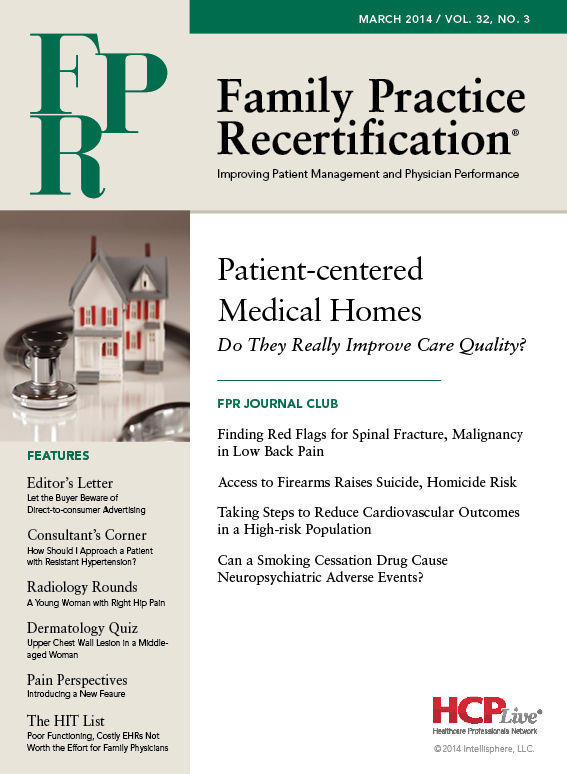Publication
Article
Family Practice Recertification
Introduction to Pain Perspectives
Author(s):
Since family physicians are more likely to adhere to a patient-centered biopsychosocial model than specialist physicians who treat chronic pain, primary care seems to be the logical "home" for its treatment.

Michael E. Schatman, PhD, CPE
As “pain specialists” willing to address the full range of issues faced by patients with pain become more scarce — mainly due to issues of remuneration and the increasing practice of defensive medicine — this unfortunate patient population is more frequently turning to family physicians (FPs) not only for assistance with pain relief, but also for help in returning to a higher quality of life.
Since FPs are more likely to adhere to a patient-centered biopsychosocial model than specialist physicians who treat chronic pain,1 primary care seems to be the logical “home” for its treatment.2 Given that low back pain is the second most common reason for primary care office visits3 and nearly half of all primary care visits are precipitated by acute pain,4 the imperative of the condition’s assessment and treatment cannot be ignored by FPs.
Unfortunately, we are approaching the point at which patients whose pain is not treated in primary care will very likely not be treated at all. FPs cannot assume that acute pain conditions will resolve simultaneously, because this belief was found to be erroneous.5 In truth, FPs can treat both acute and chronic pain effectively and in a cost-efficient manner, which is becoming more critical.6
In this new monthly column on pain management for Family Practice Recertification (FPR), a number of topics relevant to FPs who treat chronic pain will be addressed, such as:
- The improvement of primary care training in pain management
- Pharmacotherapy, including psychopharmacotherapy, in pain management
- The numerous issues pertaining to opioid therapy
- Risk mitigation in prescribing
- Strategies for becoming more biopsychosocial
- Managing patient expectations and belief systems
- Strategies for treating patients who some FPs may consider burdensome
- Treating pain in special populations like children and seniors
- Effectively utilizing guidelines to treat patients with chronic pain
- Strategies for collaborating with behavioral and addiction medicine specialists
- Issues of remuneration
- Developing a better understanding of when to refer to a specialist
- Utilizing existing and emerging technology to improve the ease and quality of pain management practice
- The moral imperative of providing the best possible treatment to patients suffering from chronic pain
However, individual readers surely will have a number of other topics under which they would appreciate additional, up-to-date, and unbiased information. Accordingly, I anticipate this column will be heavily influenced by provider requests, to which all will receive response.
The landscape of chronic pain management is changing dramatically. Some of these changes will likely result in increased physician comfort with treating this disease, while others will make the provision of effective treatment even more challenging. FPR readers may be quite surprised by the wealth of potentially useful research that can be applied directly to their practices, and I will try to help bridge the unfortunate gap that has developed between researchers and clinicians in pain medicine.7 In doing so, this column will hopefully make all of us more competent, confident, and satisfied pain managers.
References
1. Wiedemer NL, Harden PS, Arndt IO, Gallagher RM. The opioid renewal clinic: a primary care, managed approach to opioid therapy in chronic pain patients at risk for substance abuse. Pain Med. 2007;8:573-84. http://www.ncbi.nlm.nih.gov/pubmed/17883742.
2. Von Korff MR. Opioids for chronic noncancer pain: As the pendulum swings, who should set prescribing standards for primary care? Ann Fam Med. 2012:10:302-3. http://www.annfammed.org/content/10/4/302.full.
3. Nimgade A, McNeely E, Milton D, et al. Increased expenditures for other health conditions after an incident of low back pain. Spine 2010;35:769—77. http://www.ncbi.nlm.nih.gov/pubmed/20228698.
4. McCarberg BH. Pain management in primary care: strategies to mitigate opioid misuse, abuse, and diversion. Postgrad Med. 2011;23:119-30. http://www.ncbi.nlm.nih.gov/pubmed/21474900.
5. Itz CJ, Geurts JW, van Cleef M, Nelemans P. Clinical course of non-specific low back pain: a systematic review of prospective cohort studies set in primary care. Eur J Pain 2013;17:5-15. http://www.ncbi.nlm.nih.gov/pubmed/22641374.
6. Whitehurst DGT, Bryan S, Lewis M, Hill J, Hay EM. Exploring the cost—utility of stratified primary care management for low back pain compared with current best practice within risk-defined subgroups. Ann Rheum Dis. 2012;71:1796-1802. http://www.ncbi.nlm.nih.gov/pubmed/22492783.
7. Giordano J, Schatman ME. Pain medicine from "bench to bedside": bridging the disconnect(s) between research and clinical care. J Healthc Sci Humanit. 2011;1:22-41. http://issuu.com/navymedicine/docs/jhsh_vol_1_no_1/26.
About the Author
Michael E. Schatman, PhD, CPE, is a clinical psychologist who has spent the past 27 years working in pain management. He is currently the Executive Director of the Foundation for Ethics in Pain Care in Bellevue, WA, where he also maintains a part-time practice in pain psychology. Schatman is the author of more than 80 peer-reviewed and invited journal articles and book chapters on pain management, and he lectures regularly on both local and national bases. He is the editor of Ethical Issues in Chronic Pain Management and Chronic Pain Management: Guidelines for Multidisciplinary Program Development, both of which were released in 2007. Currently, he is Editor-in-Chief of the Journal of Pain Research, Ethics Section Head Editor of Pain Medicine and Psychological Injury & Law, and Deputy Editor-in-Chief of the International Journal of Cannabinoid Medicine. Schatman serves on the Board of Directors of the American Society of Pain Educators, which named him 2011 Clinical Pain Educator of the Year.






